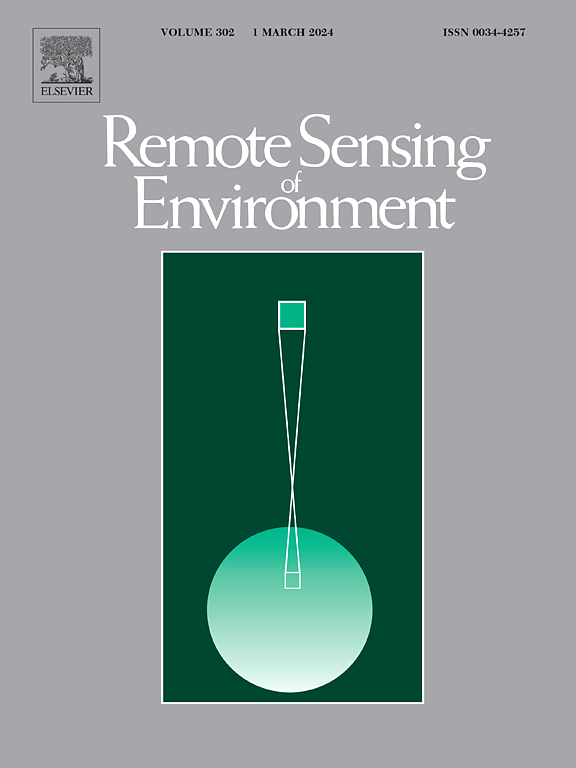Linear integrated mass enhancement: A method for estimating hotspot emission rates from space-based plume observations
IF 11.1
1区 地球科学
Q1 ENVIRONMENTAL SCIENCES
引用次数: 0
Abstract
In this paper, we propose a new methodology for plume inversion emission estimation termed linear integrated mass enhancement (LIME). As the name implies, this approach is based on the integrated mass enhancement (IME) method and on the linear relationship between IME and the distance from the source. The proposed approach accounts for the information coming from different portions of the plume, and it can be seen as a “combination” of the cross-sectional flux (CSF) method and IME. The method offers a straightforward way to estimate the source strength by determining the slope of the linear fit. We test the LIME approach with both real (OCO-3, S5P/TROPOMI, Sentinel-2) and simulated (MicroHH, SMARTCARB) satellite data. We apply the method to the simulated carbon dioxide (CO) observations for the upcoming CO2M mission over the Matimba and Jänschwalde power stations with known source rates. We use the OCO-3 data to estimate the CO emissions originating from the Bełchatów power station in Poland (between 72 and 103 ktCO/d). We also estimate the emissions from two methane (CH) leaking sites in Algeria based on S5P/TROPOMI (77 and 47 tCH/h for two days) and Sentinel-2 (7.7 tCH/h) observations. Finally, we apply the LIME method to the Sentinel-2 retrievals from a controlled CH release in Arizona. Across all case studies, the LIME emission estimates are in agreement with the expected values. The LIME estimates are also aligned with the state-of-the-art IME emission estimates, which are calculated as byproducts in the LIME emission estimation process.


线性综合质量增强:一种估算天基羽流观测热点排放率的方法
本文提出了一种新的羽流反演发射估计方法——线性积分质量增强法(LIME)。顾名思义,这种方法是基于集成质量增强(IME)方法,并基于IME与源距离之间的线性关系。所提出的方法考虑了来自羽流不同部分的信息,可以看作是横截面通量(CSF)方法和IME方法的“结合”。该方法提供了一种通过确定线性拟合的斜率来估计震源强度的直接方法。我们用真实的(OCO-3, S5P/TROPOMI, Sentinel-2)和模拟的(MicroHH, SMARTCARB)卫星数据测试了LIME方法。我们将该方法应用于即将到来的CO2M任务在已知源速率的Matimba和Jänschwalde发电站上的模拟二氧化碳(CO22)观测。我们使用OCO-3数据来估计波兰Bełchatów发电站的二氧化碳排放量(在72至103千吨二氧化碳/天之间)。我们还基于S5P/TROPOMI(两天77和47 tCH44/h)和Sentinel-2 (7.7 tCH44/h)观测值估算了阿尔及利亚两个甲烷泄漏点的排放。最后,我们将LIME方法应用于亚利桑那州控制CH44释放的Sentinel-2检索。在所有案例研究中,LIME排放估计值与期望值一致。LIME估计也与最先进的IME排放估计保持一致,后者是作为LIME排放估计过程中的副产品计算的。
本文章由计算机程序翻译,如有差异,请以英文原文为准。
求助全文
约1分钟内获得全文
求助全文
来源期刊

Remote Sensing of Environment
环境科学-成像科学与照相技术
CiteScore
25.10
自引率
8.90%
发文量
455
审稿时长
53 days
期刊介绍:
Remote Sensing of Environment (RSE) serves the Earth observation community by disseminating results on the theory, science, applications, and technology that contribute to advancing the field of remote sensing. With a thoroughly interdisciplinary approach, RSE encompasses terrestrial, oceanic, and atmospheric sensing.
The journal emphasizes biophysical and quantitative approaches to remote sensing at local to global scales, covering a diverse range of applications and techniques.
RSE serves as a vital platform for the exchange of knowledge and advancements in the dynamic field of remote sensing.
 求助内容:
求助内容: 应助结果提醒方式:
应助结果提醒方式:


